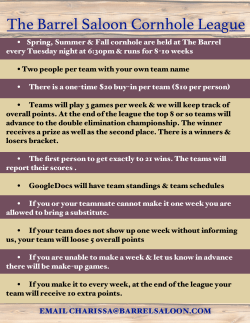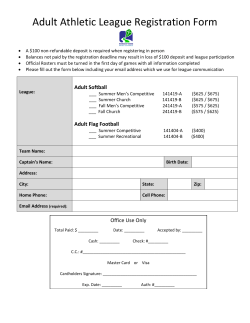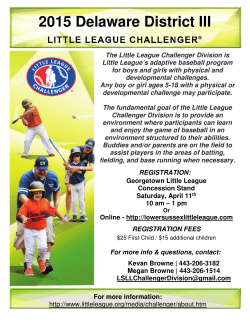
2014 Bat Rules Npgl
Bat Rules 2015 The NPGL utilizes Cal Ripken Jr., Babe Ruth and Little League Bat Rules in order to accommodate the many teams that have entered our league. The following information is taken directly from the websites of such organizations. NPGL Addendum 2013.1 (14u -‐5) and (13u -‐8) and approved bats. All -‐3 approved Bats have a stamp located on barrel. All -‐3 bats have to be BBCOR, all -‐3 non-‐BBCOR are illegal (dangerous) Ripken/Babe Ruth League APPROVED BATS as of 2013: To follow up our previous correspondence and information posted on the Babe Ruth League website, the following details on all baseball bats approved by Babe Ruth League, Inc. for 2013 local league and tournament play. Such descriptions are included as part of the 2013 Babe Ruth League Rules and Regulations. CAL RIPKEN BASEBALL DIVISION The bat may not exceed 33"in length, and the bat barrel may not exceed 2¼" in diameter. Only 2¼" barrel non-‐wood bats marked BPF 1.15 will be allowed. Wood 2 ¼" barrel bats are allowed. 13-‐15 BASEBALL DIVISION The bat may not exceed 34" in length, and the bat barrel may not exceed 2 5/8" in diameter. All aluminum/alloy barrel bats and all composite handle (only) aluminum/alloy barrels are allowed. Only composite barrel bats certified and marked BBCOR .50 will be allowed. Wood barrel bats conforming to the specifications of Official Baseball Rule 1.10 are allowed. 16-‐18 BASEBALL DIVISION The bat may not exceed 34" in length and the bat barrel many not exceed 2 5/8" in diameter or be greater than a -‐3 length to weight ratio. Only metal/composite bats certified and marked BBCOR .50 are allowed. Wood barrel bats conforming to the specifications of Official Baseball Rule 1.10 are allowed. NON-‐COMPLIANT BATS FOR 2013 -‐ BABE RUTH/CAL RIPKEN: Contained below is a current listing of non-‐compliant bats that are not eligible, or approved, for use in any Babe Ruth/Cal Ripken Baseball program or activity. nNpglbaseball.com 2 * Babe Ruth League, Inc. has been informed that Nike Bat Model #Aero CX2-‐BTO636 (light grey), CX2-‐BTO573 (dark grey) and CX2-‐BTO598 (blue)have failed recent performance standard compliance testing. Effective immediately and until further notice, Nike Bat Model #Aero CX2-‐BTO636 (light grey), CX2-‐BTO573 (dark grey) and CX2-‐BTO598 (blue), including all graphic variations, is not eligible, or approved, for use in any Babe Ruth/Cal Ripken program or activity. * The National Collegiate Athletic Association (NCAA) has advised Babe Ruth League, Inc. that the BBCOR decertification process has been implemented for the following bats: Marucci CAT-‐52 33-‐inch model, CAT-‐52 34-‐inch model, and Black 33-‐inch and 34-‐inch models Reebok Vector-‐TLS 33-‐inch model * Babe Ruth League, Inc. has been informed that Louisville Slugger TPX Dynasty -‐12, (black/red/grey) composite bat has failed recent performance standard compliance testing. Effective immediately and until further notice, Louisville Slugger (Hillerich & Bradsby) TPX Dynasty bat (Model -‐ YB12D -‐-‐ (black/red/grey) including all graphic variations, is not eligible, or approved, for use in any Babe Ruth/Cal Ripken program or activity. * Babe Ruth League, Inc. has been informed that Mattingly Sports, Inc., Balistk (blue) composite bat has failed recent performance standard compliance testing. Effective immediately and until further notice, Mattingly Sports, Inc., Balistk bat (Model -‐ BTKYB, blue) including all graphic variations, is not eligible, or approved, for use in any Babe Ruth/Cal Ripken program or activity. Effective immediately and until further notice, the bats listed above are not eligible, or approved, for use in any Babe Ruth/Cal Ripken program or activity. NON-‐COMPLIANT BATS FOR 2013 -‐ BABE RUTH SOFTBALL: Contained below is a current listing of non-‐compliant bats that are not eligible, or approved, for use in any Babe Ruth Softball program or activity. * Babe Ruth League Softball has been advised that Louisville Slugger is recalling the entire current line of the OneX fastpitch softball bat (all lengths and weights) from the market. Effectively immediately and until notified otherwise, these bats are no longer approved for play in any level of the Babe Ruth Softball program. It should be noted that both the National Collegiate Athletic Association (NCAA) and the National Federation of State High School Associations (NFHS) have taken similar action at the request of Louisville Slugger. 3 What are the current rules and regulations regarding Youth baseball bats? Composite Ban Little League and Cal Ripken leagues have banned the use of composite-‐barreled bats effective January 1, 2011. Manufacturers are able to apply for one year waivers for their composite bats, and testing is currently under way. A few bats have received waivers already and you can find a full list of approved bats here. BatWarehouse.com will prominently display which youth composite bats have received a waiver underneath the picture of the specific bat. This does not mean that all composite youth bats are banned in all leagues. Currently, these bats are only banned in a couple of leagues. The majority of youth players can still use composite-‐barreled bats. Check with your league director if you are unsure of the rules governing your league. Hybrid bats, that is bats with a composite handle and alloy barrel, ARE LEGAL for all leagues at this point in time. The ban only applies to bats with a composite barrel BPF 1.15 Youth bats are almost universally governed by the 1.15 BPF. BPF stands for Bat Performance Factor, and measures the how fast the ball comes off the bat. Bats must meet this BPF standard in order to be approved for play. Nearly all youth bats are stamped with the 1.15 BPF mark. The following information is courtesy of littleleague.org. The rules regarding baseball bats for 2012 are: Rule 1.10 -‐ Baseball -‐ The bat must be a baseball bat which meets Little League specifications and standards as noted in this rule. It shall be a smooth, rounded stick and made of wood or of material and color tested and proved acceptable to Little League standards. Little League (Majors) and below: it shall not be more than thirty-‐three (33) inches in length nor more than two and one-‐quarter (2¼) inches in diameter. Non-‐wood bats shall be labeled with a BPF (bat performance factor) of 1.15 or less; EXCEPTION: For the 2011-‐2012 Little League (Majors) and below, for regular season play and Tournament, composite bats are prohibited unless approved by Little League International. A list of approved and licensed composite bats can be found on the Little League website at www.littleleague.org. 4 Junior League: it shall not be more than 34 inches in length; nor more than 2 5/8 inches in diameter, and if wood, not less than fifteen-‐sixteenths (15/16) inches in diameter (7/8 inch for bats less than 30”) at its smallest part. All composite bats shall meet the Batted Ball Coefficient of Restitution (BBCOR) performance standard, and such bats shall be so labeled with a silkscreen or other permanent certification mark. The certification mark shall be rectangular, a minimum of a half-‐inch on each side and located on the barrel of the bat in any contrasting color. Senior/Big League: it shall not be more than 36 inches in length, nor more than 2 5/8 inches in diameter, and if wood, not less than fifteen-‐sixteenths (15/16) inches in diameter (7/8 inch for bats less than 30”) at its smallest part. The bat shall not weigh, numerically, more than three ounces less than the length of the bat (e.g., a 33-‐inch-‐long bat cannot weigh less than 30 ounces). All bats not made of a single piece of wood shall meet the Batted Ball Coefficient of Restitution (BBCOR) performance standard, and such bats shall be so labeled with a silkscreen or other permanent certification mark. The certification mark shall be rectangular, a minimum of a half-‐inch on each side and located on the barrel of the bat in any contrasting color. Aluminum and composite bats shall be marked as to their material makeup being aluminum or composite. This marking shall be silkscreen or other permanent certification mark, a minimum of one-‐half-‐inch on each side and located on the barrel of the bat in any contrasting color. In all divisions, wood bats may be taped or fitted with a sleeve for a distance not exceeding sixteen (16) inches (18 inches for Junior/Senior/Big League baseball) from the small end. A non-‐wood bat must have a grip of cork, tape or composition material, and must extend a minimum of 10 inches from the small end. Slippery tape or similar material is prohibited. NOTE 1: Junior/Senior/Big League: The 2 3/4 inch in diameter bat is not allowed in any division. NOTE 2: The traditional batting donut is not permissible NOTE 3: The bat may carry the mark "Little League Tee Ball." NOTE 4: Non-‐wood bats may develop dents from time to time. Bats that cannot pass through the approved Little League bat ring for the appropriate division must be removed from play. The 2¼ inch bat ring must be used for bats in the Tee Ball, Minor League and Little League Baseball divisions. The 2 5/8 inch bat ring must be used for bats in the Junior, Senior and Big League divisions of baseball. NOTE 5: An illegal bat must be removed. Any bat that has been altered shall be removed from play. Penalty – See Rule – 6.06 (d). 5 Little League Bat Rules The following information is courtesy of littleleague.org. The rules regarding baseball bats for 2012 are: Rule 1.10 -‐ Baseball -‐ The bat must be a baseball bat which meets Little League specifications and standards as noted in this rule. It shall be a smooth, rounded stick and made of wood or of material and color tested and proved acceptable to Little League standards. Little League (Majors) and below: it shall not be more than thirty-‐three (33) inches in length nor more than two and one-‐quarter (2¼) inches in diameter. Non-‐wood bats shall be labeled with a BPF (bat performance factor) of 1.15 or less; EXCEPTION: For the 2011-‐2012 Little League (Majors) and below, for regular season play and Tournament, composite bats are prohibited unless approved by Little League International. A list of approved and licensed composite bats can be found on the Little League website at www.littleleague.org. Junior League: it shall not be more than 34 inches in length; nor more than 2 5/8 inches in diameter, and if wood, not less than fifteen-‐sixteenths (15/16) inches in diameter (7/8 inch for bats less than 30”) at its smallest part. All composite bats shall meet the Batted Ball Coefficient of Restitution (BBCOR) performance standard, and such bats shall be so labeled with a silkscreen or other permanent certification mark. The certification mark shall be rectangular, a minimum of a half-‐inch on each side and located on the barrel of the bat in any contrasting color. Senior/Big League: it shall not be more than 36 inches in length, nor more than 2 5/8 inches in diameter, and if wood, not less than fifteen-‐sixteenths (15/16) inches in diameter (7/8 inch for bats less than 30”) at its smallest part. The bat shall not weigh, numerically, more than three ounces less than the length of the bat (e.g., a 33-‐inch-‐long bat cannot weigh less than 30 ounces). All bats not made of a single piece of wood shall meet the Batted Ball Coefficient of Restitution (BBCOR) performance standard, and such bats shall be so labeled with a silkscreen or other permanent certification mark. The certification mark shall be rectangular, a minimum of a half-‐inch on each side and located on the barrel of the bat in any contrasting color. Aluminum and composite bats shall be marked as to their material makeup being aluminum or composite. This marking shall be silkscreen or other permanent certification mark, a minimum of one-‐half-‐inch on each side and located on the barrel of the bat in any contrasting color. In all divisions, wood bats may be taped or fitted with a sleeve for a distance not exceeding sixteen (16) inches (18 inches for Junior/Senior/Big League baseball) from the small end. A non-‐wood bat must have a grip of cork, tape or composition material, and must extend a minimum of 10 inches from the small end. Slippery tape or similar material is prohibited. 6 NOTE 1: Junior/Senior/Big League: The 2 3/4 inch in diameter bat is not allowed in any division. NOTE 2: The traditional batting donut is not permissible NOTE 3: The bat may carry the mark "Little League Tee Ball." NOTE 4: Non-‐wood bats may develop dents from time to time. Bats that cannot pass through the approved Little League bat ring for the appropriate division must be removed from play. The 2¼ inch bat ring must be used for bats in the Tee Ball, Minor League and Little League Baseball divisions. The 2 5/8 inch bat ring must be used for bats in the Junior, Senior and Big League divisions of baseball. NOTE 5: An illegal bat must be removed. Any bat that has been altered shall be removed from play. Penalty – See Rule – 6.06 (d).
© Copyright 2025









